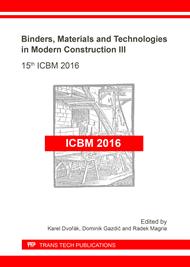p.3
p.10
p.15
p.21
p.29
p.35
p.40
p.45
Polymercement Composites in Environment with Increased Concentration of Sulfate Ions and Extreme Temperatures
Abstract:
Polymer cement matrix based materials were designed within the frame of the research presented in this paper. Resistance of these materials to combination of several adverse factors was observed. Considerable proportion of input materials used were components from alternative material resources. Primary binder was replaced with fly ash and blast furnace slag. Dominant proportion of filling mass was taken up by agloporite – porous aggregate produced by self-baking from fly ash. The focus of the research was assessment of degradation of materials after long-term exposition (up to 90 days) to increased concentration of sulphate ions and high temperatures. Degree of degradation was evaluated on the basis of physico-mechanical and physico-chemical tests combined with microstructural analyses.
Info:
Periodical:
Pages:
10-14
Citation:
Online since:
October 2017
Authors:
Price:
Сopyright:
© 2017 Trans Tech Publications Ltd. All Rights Reserved
Share:
Citation:


